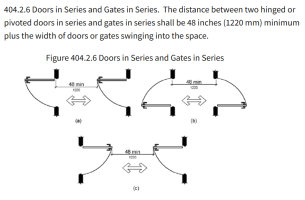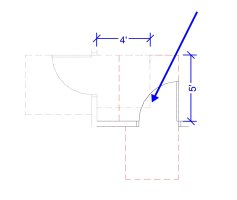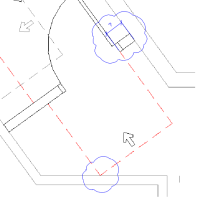-
Welcome to The Building Code Forum
Your premier resource for building code knowledge.
This forum remains free to the public thanks to the generous support of our Sawhorse Members and Corporate Sponsors. Their contributions help keep this community thriving and accessible.
Want enhanced access to expert discussions and exclusive features? Learn more about the benefits here.
Ready to upgrade? Log in and upgrade now.
You are using an out of date browser. It may not display this or other websites correctly.
You should upgrade or use an alternative browser.
You should upgrade or use an alternative browser.
Door swing clearance
- Thread starter FakeArchitect
- Start date
There is no prohibition in either the ICC A117.1 or the ADA/ABA Standards against doors swinging into the maneuvering clearances of another door.
FakeArchitect
REGISTERED
Appreciate the quick response sir!There is no prohibition in either the ICC A117.1 or the ADA/ABA Standards against doors swinging into the maneuvering clearances of another door.
I looked into TAS as well,under Chapter 4 there is a door in series which lists a minimum of 48” between doors in addition to the width of the door. But it is a different situation than the one attached…
It does list that the door maneuvering clearance can overlap, but in this situation it’s the door swing itself that is in the clearance..
arwat23
SAWHORSE
Depending on the space around these doors and the jurisdiction, this might be considered "doors in a series". I've have jurisdictions call this situation that before (even though I disagree with them). Just wanted to share in case your jurisdiction has that same opinion.Appreciate the quick response sir!
I looked into TAS as well,under Chapter 4 there is a door in series which lists a minimum of 48” between doors in addition to the width of the door. But it is a different situation than the one attached…
It does list that the door maneuvering clearance can overlap, but in this situation it’s the door swing itself that is in the clearance..
As far as I'm aware, there's nothing saying doors cannot overlap the maneuvering clearances of other doors. Here's a link to something that applies to ADAS (probably applies to TAS too since my understanding is that TAS is mostly ADAS). My understanding the list in that link are the only times a door's swing cannot overlap another required clearance.
FakeArchitect
REGISTERED
Really appreciate the input and link. This is super helpful.Depending on the space around these doors and the jurisdiction, this might be considered "doors in a series". I've have jurisdictions call this situation that before (even though I disagree with them). Just wanted to share in case your jurisdiction has that same opinion.
As far as I'm aware, there's nothing saying doors cannot overlap the maneuvering clearances of other doors. Here's a link to something that applies to ADAS (probably applies to TAS too since my understanding is that TAS is mostly ADAS). My understanding the list in that link are the only times a door's swing cannot overlap another required clearance.
The doors are in a bit of a bind, but the door with clearance in red opens into corridor on either side and the other door opens into a room. But as far as the link goes, I think they don’t fall in any of those situations…
Thanks!
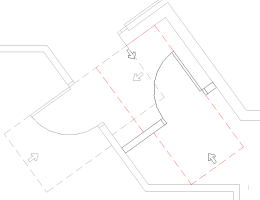
arwat23
SAWHORSE
Do both of these doors have closers? Could you argue that the door to the left has a hinge approach rather than a front approach?
If there's concern (code or practice) with the maneuvering clearance and door swing, removing the closer or calling for a hinge approach may be sufficient to get the maneuvering clearance out of the door swing.
If there's concern (code or practice) with the maneuvering clearance and door swing, removing the closer or calling for a hinge approach may be sufficient to get the maneuvering clearance out of the door swing.
FakeArchitect
REGISTERED
Appreciate the discussion, I am learning a lot just by having this conversation.Do both of these doors have closers? Could you argue that the door to the left has a hinge approach rather than a front approach?
If there's concern (code or practice) with the maneuvering clearance and door swing, removing the closer or calling for a hinge approach may be sufficient to get the maneuvering clearance out of the door swing.
Apologies for the delayed response. I was trying to get more information on this lol, the door to the left is a secured door which has closer, the right one does not... You think this could be an issue if these are considered a series of doors? Thanks
arwat23
SAWHORSE
It's possible. Most jurisdictions I've worked in wouldn't consider this doors in a series. There is one, however, that would undoubtable consider this doors in a series.You think this could be an issue if these are considered a series of doors?
Odds are you're probably okay.
walker.t
SAWHORSE
Yikes
SAWHORSE
See also my post and the larger thread here from 2022: https://www.thebuildingcodeforum.com/forum/threads/two-doors-in-a-series.31230/post-257723
It references the image of an accessible hotel room as published by the USDOJ in section 806 of https://www.ada.gov/regs2010/2010ADAStandards/Guidance2010ADAstandards.htm
That hotel room had a bathroom door that was closer than 4' from the hotel room entry door.
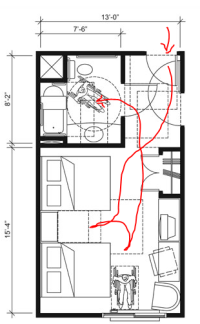
It references the image of an accessible hotel room as published by the USDOJ in section 806 of https://www.ada.gov/regs2010/2010ADAStandards/Guidance2010ADAstandards.htm
That hotel room had a bathroom door that was closer than 4' from the hotel room entry door.

Paul Sweet
SAWHORSE
ADASAD 304.4 allows doors to swing into a turning space, so I think that a door swing can overlap a maneuvering clearance as long as it leaves a clear 30" x 48" space for a wheelchair.
Jean Tessmer-HI
REGISTERED
Check ADA 404.2.6 illustration is attached. The illustration shows you cannot overlap door clear floor spaces.Hey!
Any advice appreciated on this, can door push clearances and Door swing overlap each other? Like the one in the image?
I’ve done some research and was not able to find something definitive, or maybe my research or understanding might be deficient…
View attachment 15760
